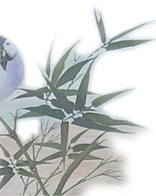|
Mogu is also called boneless painting.
Maybe you would like to ask, since Shirley said that line is the skeleton (or bone) of Chinese painting, why there is a boneless painting here? In fact, the lines in Chinese Baimiao and Gongbi paintings, all of the lines are painted by Chinese ink and the ink line is just the skeleton (or bone) of a painting. In Chinese Xieyi Painting, the lines are still the bones or skeleton of a painting, but they are freer, some of the lines are painted by Chinese ink, some of them are colored.
Chinese Mogu is a boneless painting. That does not mean there is no any line in is, but the lines in the Chinese Mogu painting were done by colors, instead of ink lines. This is its first character.
Chinese Mogu Painting and Chinese Gongbi Painting use almost the same materials and carriers, but a Chinese Mogo painting needs to use water much more than Chinese Gongbi painting, just like colored water. People are used to putting the different colors in the same place that has been limited by the lines and let them to be mixed freely by themselves, making and made a special artistic result. This is its second character.
Sometimes, people color the objects within the different outlines of pencil. After the color is dry, remove the pencil lines and create some new colored lines that have been done on the boundary between the different colors places.
Therefore, it is a painting between Chinese Gongbi and Chinese Xieyi. Its lines are Chinese Gongbi style, but not ink line; its color application is free, its free style is near Chinese Xieyi, but it is not beyond the outline of the lines as Gongbi paintings.
Mogu was created by Zhang Zengyao during the Northern and Southern Dynasties (420-589).
In the Five Dynasties period (907-960), Huang Quan significantly developed it to paint trees and flowers.
In Tang Dynasty (618 - 917), Yang Sheng mastered and developed it. In Ming Dynasty (1368 to 1644), Xu Wei further developed it and he started applying this technique landscape paintings.
In Song Dynasty (960 - 1127), Mogu as a new word and the name of a painting appeared in a book by Guo Ruo Xu
In Qing Dynasty (1644-1911), Yun Shouping (Yun Nantian) made it famous and Ren Bonian and Wu Changshuo developed it further.
If we see Chinese Gongbi painting and Xieyi painting as the mainstreams of traditional Chinese paintings, then Mogu painting is just a small stream in Chinese painting history. Until now, there are still few people working on it, but it is still developing silently and contributes its beautiful to the world.
I started to touch and to learn Mugo painting in the China Central Academy of Fine Arts in 2012. Then I studied it at the Chinese National Academy of Arts. Many of my tutors think it is the painting form that suits me most most suitable me. So, they have suggested me working to work on it in my future art study.
Now I would like to share some of my Chinese Mogu paintings which are my assignments in the two schools and I hope you enjoy them and hear your comments.
Sincerely
Shirley Yiping Zhang
Nov 14, 2016
shirley@ebridge.cn
www.ebridge.cn
|

